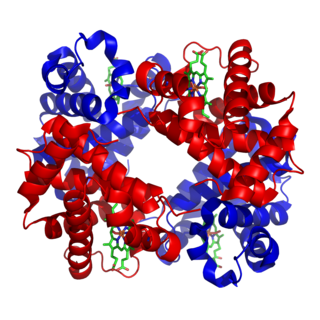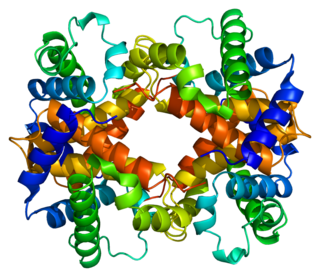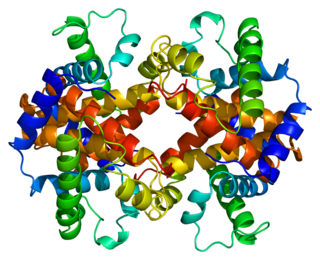Hemoglobin subunit gamma-2 is a protein that in humans is encoded by the HBG2 gene. [5]
Hemoglobin subunit gamma-2 is a protein that in humans is encoded by the HBG2 gene. [5]
The gamma globin genes (HBG1 and HBG2, this gene) are normally expressed in the fetal liver, spleen and bone marrow. Two gamma chains together with two alpha chains constitute fetal hemoglobin (HbF) which is normally replaced by adult hemoglobin (HbA) at birth. In some beta-thalassemias and related conditions, gamma chain production continues into adulthood. The two types of gamma chains differ at residue 136 where glycine is found in the G-gamma product (HBG2) and alanine is found in the A-gamma product (HBG1). The former is predominant at birth. The order of the genes in the beta-globin cluster is: 5' - epsilon – gamma-G – gamma-A – delta – beta - 3'. [6]

Hemoglobin A (HbA), also known as adult hemoglobin, hemoglobin A1 or α2β2, is the most common human hemoglobin tetramer, accounting for over 97% of the total red blood cell hemoglobin. Hemoglobin is an oxygen-binding protein, found in erythrocytes, which transports oxygen from the lungs to the tissues. Hemoglobin A is the most common adult form of hemoglobin and exists as a tetramer containing two alpha subunits and two beta subunits (α2β2). Hemaglobin A2 (HbA2) is a less common adult form of hemoglobin and is composed of two alpha and two delta-globin subunits. This hemoglobin makes up 1-3% of hemoglobin in adults.
A locus control region (LCR) is a long-range cis-regulatory element that enhances expression of linked genes at distal chromatin sites. It functions in a copy number-dependent manner and is tissue-specific, as seen in the selective expression of β-globin genes in erythroid cells. Expression levels of genes can be modified by the LCR and gene-proximal elements, such as promoters, enhancers, and silencers. The LCR functions by recruiting chromatin-modifying, coactivator, and transcription complexes. Its sequence is conserved in many vertebrates, and conservation of specific sites may suggest importance in function. It has been compared to a super-enhancer as both perform long-range cis regulation via recruitment of the transcription complex.
The human β-globin locus is composed of five genes located on a short region of chromosome 11, responsible for the creation of the beta parts of the oxygen transport protein Haemoglobin. This locus contains not only the beta globin gene but also delta, gamma-A, gamma-G, and epsilon globin. Expression of all of these genes is controlled by single locus control region (LCR), and the genes are differentially expressed throughout development.

Beta globin is a globin protein, which along with alpha globin (HBA), makes up the most common form of haemoglobin in adult humans, the HbA. It is 146 amino acids long and has a molecular weight of 15,867 Da. Normal adult human HbA is a heterotetramer consisting of two alpha chains and two beta chains.

Hemoglobin variants are mutant forms of hemoglobin in a population, caused by variations in genetics. Some well-known hemoglobin variants such as sickle-cell anemia are responsible for diseases, and are considered hemoglobinopathies. Other variants cause no detectable pathology, and are thus considered non-pathological variants.

Krueppel-like factor 1 is a protein that in humans is encoded by the KLF1 gene. The gene for KLF1 is on the human chromosome 19 and on mouse chromosome 8. Krueppel-like factor 1 is a transcription factor that is necessary for the proper maturation of erythroid cells.

Hemoglobin, alpha 1, also known as HBA1, is a hemoglobin protein that in humans is encoded by the HBA1 gene.

Gamma-aminobutyric acid receptor subunit gamma-2 is a protein that in humans is encoded by the GABRG2 gene.

Hemoglobin subunit delta is a protein that in humans is encoded by the HBD gene.

Hemoglobin subunit gamma-1 is a protein that in humans is encoded by the HBG1 gene.

Hemoglobin subunit epsilon is a protein that in humans is encoded by the HBE1 gene.

Hemoglobin subunit zeta is a protein that in humans is encoded by the HBZ gene.

Isocitrate dehydrogenase [NAD] subunit alpha, mitochondrial (IDH3α) is an enzyme that in humans is encoded by the IDH3A gene.

Guanine nucleotide-binding protein G(I)/G(S)/G(O) subunit gamma-3 is a protein that in humans is encoded by the GNG3 gene.

Guanine nucleotide-binding protein subunit beta-4 is a protein that in humans is encoded by the GNB4 gene.

Gamma-aminobutyric acid receptor subunit alpha-4 is a protein that in humans is encoded by the GABRA4 gene.

5'-AMP-activated protein kinase subunit gamma-3 is an enzyme that in humans is encoded by the PRKAG3 gene.

Hemoglobin subunit theta-1 is a protein that in humans is encoded by the HBQ1 gene.
The human embryonic haemoglobins were discovered in 1961. These include Hb-Gower 1, consisting of 2 zeta chains and 2 epsilon chains, and Hb-Gower 2, which consists of 2 αlpha-chains and 2 epsilon-chains, the zeta and epsilon chains being the embryonic haemoglobin chains.

Hemoglobin, alpha 2 also known as HBA2 is a gene that in humans codes for the alpha globin chain of hemoglobin.
| This protein-related article is a stub. You can help Wikipedia by expanding it. |